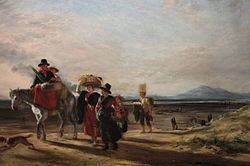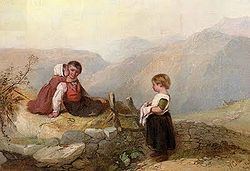Name William Collins Role Painter | Spouse Harriet Collins (m. 1822) Parents William Collins Snr. | |
Children Wilkie Collins, Charles Allston Collins Grandchildren Harriet Constance Dawson, Marian Dawson, William Charles Dawson Similar People Wilkie Collins, Charles Allston Collins, Kate Perugini, Charles Dickens, Catherine Dickens | ||
George william collins artist sulis fine art
William Collins (8 September 1788 in London – 17 February 1847 in London) was an English landscape and genre painter. In the late 19th century his work was more popular and highly valued than even that of J M W Turner or John Constable.
Contents

Life and work

Collins was born in Great Titchfield Street, London, son of William Collins Sr., an Irish-born picture-dealer and writer. He showed a great aptitude for art from an early age, and was, for a while, an informal pupil of George Morland. In 1807, he entered the schools of the Royal Academy (at the same time as William Etty), and exhibited at the Academy for the first time in the same year. In 1809 he was awarded a medal in the life school, and exhibited three pictures - Boy at Breakfast, Boys with a Bird's-nest and a Portrait of Master Lee as he spoke the Prologue at the Haymarket Theatre.
In 1811, Collins sold a picture entitled The Young Fifer, to the Marquis of Stafford for 80 guineas, and the next year produced the work which made him famous, The Sale of the Pet Lamb, which was sold for 140 forty guineas and engraved by S. W. Reynolds. He now became the chief support of his family - following the death of his father (in financial difficulty) in that year - and found some valuable patrons, especially Sir Thomas Freeman Heathcote, Sir John Leicester, Sir Robert Peel, Sir George Beaumont, and Lord Liverpool. In 1814 two pictures, The Blackberry Gatherers and The Birdcatchers (both sold privately), won him an associateship of the Royal Academy (ARA).
In 1815, Collins undertook a sketching tour of the coast near Cromer, and produced a Scene on the Coast of Norfolk which was acquired by the Prince Regent. In 1817 he visited Paris with Leslie and Washington Allston, and painted The Departure of the Diligence from Rouen, and the Scene on the Boulevards (both sold privately) - these were exhibited at the Royal Academy in 1818. He also painted several portraits around this time.
In 1820, Collins was elected a Royal Academician (RA), presenting as his diploma picture The Young Anglers. In 1822 he married Harriet Geddes, sister of the portrait painter Margaret Sarah Carpenter. He continued to exhibit and travel in England and Scotland, and his art enjoyed great popularity. In 1826 he painted The Fisherman's Departure, (engraved by Phelps), and in 1828 made a tour of the Netherlands and Belgium, living for short time in Boulogne in 1836. Rustic Hospitality was painted in 1834, and, in 1836, Sunday Morning and As Happy as a King, the subject of the latter picture having been suggested to Collins by the story of a country boy whose ideal of regal happiness was swinging upon a gate all day long and eating fat bacon.
In September 1836, Collins left London for Italy, where he remained there until 1838. During these two years he occupied himself unremittingly in advancing his knowledge of painting, but had to return due to illness. He then begun a series of pictures depicting Italian life including Poor Travellers at the door of a Capuchin Convent near Vico, Bay of Naples and A Scene near Subiaco, which were exhibited at the Royal Academy in 1839. These were followed in 1840-1 by two subjects taken from the New Testament - Our Saviour with the Doctors in the Temple, and The Two Disciples at Emmaus.
From 1840 to 1842 Collins was librarian to the Royal Academy and in 1843 he moved to a large house at 1 Devonport Street, Hyde Park Gardens. In 1840 he visited Germany, and in 1842 the Shetland Islands - the latter journey inspiring him to produce a series of illustrations for Sir Walter Scott's novel Pirate, which were published in the "Waverley" edition of the book.
In 1846 Collins' Early Morning was exhibited. Ruskin said of it "I have never seen the oppression of sunlight in a clear, lurid, rainy atmosphere more perfectly or faithfully rendered, and the various portions of reflected and scattered light are all studied with equal truth and solemn feeling." Collins also produced some watercolours, such as The Rat-catcher, Landing Fish, A Street in Naples and Kentish Peasant Girls, and made several etchings, most of which, along with engravings of his best work, were given to the British Museum by Mrs. Collins.
Death
Collins died from heart disease, "terminating in dropsy", in Devonport Street, on 17 February 1847, and was buried in the cemetery of the church of St. Mary, Paddington, where a handsome monument, in the form of a cross, was erected to his memory by his widow. The grave now stands isolated, on the north side of St Marys Gardens, following the churchyard's conversion to a public park in 1881. The grave has been vandalised and the marble cross is missing. The inscription is also eroding.
He left two sons: The elder, William Wilkie Collins, the novelist named after his godfather, the artist David Wilkie, wrote a biography of his father entitled "Memoirs of the Life of William Collins, Esq., R.A." (1848). The younger son, Charles Allston Collins was also a painter.
Works
Collins exhibited at the Royal Academy every year from 1807–46 (a total of 124 pictures), and showed 45 pictures at the British Institution. His major works are listed in Volume 2 (pp. 341–52) of "Memoirs" (see bibliography).
Today his works are included in the collections at the Victoria and Albert Museum and Tate Britain in London and other regional centres.
